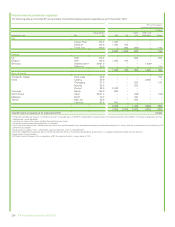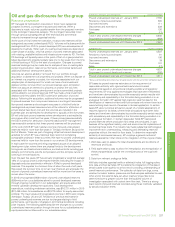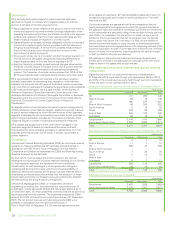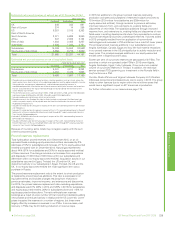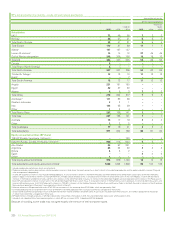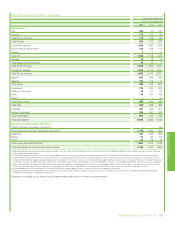BP 2015 Annual Report Download - page 225
Download and view the complete annual report
Please find page 225 of the 2015 BP annual report below. You can navigate through the pages in the report by either clicking on the pages listed below, or by using the keyword search tool below to find specific information within the annual report.
Upstream analysis by region
Our upstream operations are set out below by geographical area, with
associated significant events for 2015. BP’s percentage working interest
in oil and gas assets is shown in brackets. Working interest is the cost-
bearing ownership share of an oil or gas lease. Consequently, the
percentages disclosed for certain agreements do not necessarily reflect
the percentage interests in reserves and production.
In addition to exploration, development and production activities, our
upstream business also includes midstream and LNG supply activities.
Midstream activities involve the ownership and management of crude oil
and natural gas pipelines, processing facilities and export terminals, LNG
processing facilities and transportation, and our natural gas liquids (NGLs)
extraction business.
Our LNG supply activities are located in Abu Dhabi, Angola, Australia,
Indonesia and Trinidad. We market around 20% of our LNG production
using BP LNG shipping and contractual rights to access import terminal
capacity in the liquid markets of the US (via Cove Point), the UK (via the
Isle of Grain), Spain (in Bilbao) and Italy (in Rovigo), with the remainder
marketed directly to customers. LNG is supplied to customers in markets
including Japan, South Korea, China, the Dominican Republic, Argentina,
Brazil and Mexico.
Europe
BP is active in the North Sea and the Norwegian Sea. Our activities focus
on maximizing recovery from existing producing fields and selected new
field developments. BP’s production is generated from three key areas:
the Shetland area, comprising Magnus, Clair, Foinaven and Schiehallion
fields; the central area, comprising Bruce, Andrew and ETAP fields; and
Norway, comprising Valhall, Ula and Skarv fields.
• BP and its partners, ConocoPhillips, Chevron and Shell, announced
their decision to proceed with a two-year appraisal programme to
evaluate a potential third phase of the Clair field (BP 28.6%), west of
the Shetland Islands in March 2013. In March we completed the sixth
and final well of the programme. The Clair field partners will review the
significant amount of data collected to determine the potential for
development.
• The Quad 204 project, a major redevelopment to extend the life of the
Schiehallion and Loyal fields to the west of Shetland, continued in
2015. After successfully completing sea trials, Glen Lyon, the
replacement floating production, storage and offload vessel (FPSO),
departed South Korea in December at the start of its journey to the
Shetlands. We also ran a major offshore campaign focusing on the pre-
installation of risers and ancillary equipment in preparation for its arrival.
As well as the new FPSO, the redevelopment includes extension of
the existing subsea infrastructure and drilling new wells. In April, on
behalf of its co-venturers, BP announced the start of a seven-year
drilling campaign on the Loyal field by the new-build, semi-submersible
drilling rig, Deepsea Aberdeen.
• In June BP and its partners announced that the Clair Ridge platform’s
topside modules for accommodation and utilities had been installed.
The next major milestone will be the installation of the production and
drilling platform topside modules, scheduled for summer 2016, with
production expected to commence in late 2017.
• In July we were awarded five new blocks across two licences in the
North Sea as part of the second tranche of the 28th licensing round by
the UK Oil and Gas Authority, bringing the total blocks awarded to BP
to 12 to date in this licensing round.
• Maersk Oil announced the UK Oil and Gas Authority’s approval of
development plans for the Culzean field in the UK North Sea in August.
Culzean is operated by Maersk Oil on behalf of its partners, JX Nippon
and BP (16%).
• We completed the Magnus life extension project in July enabling
Magnus to continue safe and compliant operations. This was the first
project in our North Sea renewals programme, designed to extend the
productive life of mature assets. Production for Magnus has been
extended by five years to 2023. Additional accommodation has been
constructed to enable maintenance of this ageing facility and a return
to drilling in 2017.
• The ETAP life extension and additional living-quarters project began in
2015 and is scheduled to run through 2016. These activities aim to
delay cessation of production for the ETAP fields to 2030 by executing
maintenance scope and installing additional living quarters on the
central processing facility. Total investment on these projects is
currently estimated at $360 million gross.
• Operations at the Rhum gas field continued under a temporary
management scheme announced by the UK government in 2013.
Production was suspended between November 2010 and October
2014 following the imposition of EU sanctions on Iran. The field is
owned by BP (50%) and the Iranian Oil Company (IOC) under a joint
operating agreement. See International trade sanctions on page 242.
• In December, a number of North Sea assets were subject to
impairment charges totalling $830 million, primarily as a result of the
lower price environment. These were however more than offset by
impairment reversals of $945 million in relation to other assets in the
region arising as a result of decreases in cost estimates and a
reduction in the discount rate applied.
In the UK North Sea, BP operates the Forties Pipeline System (FPS)
(BP 100%), an integrated oil and NGLs transportation and processing
system that handles production from around 80 fields in the central
North Sea. The system has a capacity of more than 675mboe/d, with
average throughput in 2015 of 442mboe/d. BP also operated and had a
36% interest in the Central Area Transmission System (CATS), a 400-
kilometre natural gas pipeline system in the central UK sector of the
North Sea providing transport and processing services. Average
throughput in 2015 was 40mboe/d. In April, BP announced the sale of its
equity in the CATS business to Antin Infrastructure Partners for a
headline price of $486 million, and the sale completed in December. BP
also operates the Sullom Voe oil and gas terminal in Shetland.
North America
Our upstream activities in North America take place in four main areas:
deepwater Gulf of Mexico, the Lower 48 states, Alaska and Canada. For
further information on BP’s activities in connection with its
responsibilities following the Deepwater Horizon oil spill, see page 41.
BP has around 500 lease blocks in the deepwater Gulf of Mexico, making
us one of the largest portfolio owners, and operates four production hubs.
• We announced a new ownership and operating model with Chevron and
ConocoPhillips in January 2015. We sold approximately half of our equity
interests in the Gila field to Chevron in December 2014 and
approximately half of our equity interest in the Tiber field to them in
January 2015. BP, Chevron and ConocoPhillips also have agreed to joint
ownership interests in exploration blocks east of Gila known as Gibson
(BP 34%). Chevron will operate Tiber (BP 31%), Gila (BP 34%) and
Gibson. Operatorship transferred at the end of 2015 after BP finished
drilling appraisal wells at Gila and Tiber. These arrangements enable us to
support exploration and development in the Paleogene, share
development costs and maximize synergies allowing us to manage and
improve capital efficiency, as well as increase our focus on maximizing
production at our existing operated hubs.
• In the fourth quarter, BP began drilling operations on two wells, the
Chevron operated Gibson prospect and the appraisal well on the
Hopkins discovery. Both wells will complete in 2016.
• In March we incurred drilling rig contract cancellation costs of
$375 million for two deepwater drilling rigs in the Gulf of Mexico which
are no longer required for our operations.
• In November BP and its partners in the Mad Dog Phase 2 project
(BP 60.5%) approved a modified development plan and were awarded
a Suspension of Production from the US Department of the Interior.
Mad Dog Phase 2 will develop resources in the central area of the field
through a subsea development consisting of up to 24 wells from four
drill centres.
• In December we wrote off $345 million relating to costs for the Gila
discovery as these resources would be challenging to develop in the
current environment.
• See also Significant estimate or judgement: oil and natural gas
accounting on page 109 for further information on leases.
• See page 30 for further information on our Thunder Horse South
Expansion project.
Additional disclosures
*Defined on page 256. BP Annual Report and Form 20-F 2015 221

















